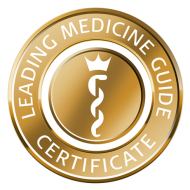Was unsere Patienten sagen
Dem ganzen Team ...
... herzlichen Dank für die liebe Betreuung während der schwierigen Zeit! Schön, dass Sie uns geholfen haben einen so liebevollen Menschen zu uns zu bringen!Babypost von Alexa Sophie
Liebes Wunschbaby-Team,wir freuen uns Sie über die Geburt unserer Tochter Alexa Sophie am 25.01. informieren zu dürfen.Wir möchten uns an dieser Stelle nochmal sehr herzlich beim gesamten Team für Alles bedanken!Wir hatten uns bei Ihnen von Beginn an sehr gut aufgehoben, sowie ausreichend informiert gefühlt.Das gesamte Team ist uns während des gesamten Behandlungszeitraumes stets freundlich, zuvorkommend.Und bemüht begegnet. Das wissen wir wirklich zu schätzen, da es keine Selbstverständlichkeit ist!Freundliche GrüßeFamilie H.
Nochmals ...
.. herzlichen Dank für alles, was Sie für uns getan haben. Eigentlich kann man es gar nicht in Worte fassen, was man empfindet, wenn das für uns fast Unmögliche doch noch „lebendig“ geworden ist. Familie P.An das ganze Team ...
... einen lieben Dank, für den letzten Schups zu unserem süßen Mädchen. Fam. H.Umfrage bestätigt: 75 % der Frauen fühlen sich beim Kinderwunsch vom Staat diskriminiert
Frauen fühlen sich bei ihrem Kinderwunsch in Österreich diskriminiert, das bestätigt eine Umfrage von Market Agent im Auftrag vom Wunschbaby Institut Feichtinger. Denn das österreichische Gesetz erlaubt das Einfrieren von Eizellen bei Frauen nicht, Männer hingegen dürfen ihre Samen einfrieren. 75 % der befragten Frauen fühlen sich daher vom Staat diskriminiert und würden sich eine Gesetzesänderung erwarten. Darüber hinaus wäre eine finanzielle Förderung des Bundes für 74% wünschenswert, da derzeit – sofern eine medizinisches Indikation vorliegt, wie etwa eine Chemotherapie oder dergleichen, das Eizelleneinfrieren erlaubt ist – bis zu 4000 Euro kostet und die Kosten hierfür komplett privat getragen werden müssen. Für Männer kostet das Einfrieren Ihrer Samen lediglich ein Zehntel.
75 % der befragten Frauen fühlen sich daher vom Staat diskriminiert und würden sich eine Gesetzesänderung erwarten. Darüber hinaus wäre eine finanzielle Förderung des Bundes für 74% wünschenswert, da derzeit – sofern eine medizinisches Indikation vorliegt, wie etwa eine Chemotherapie oder dergleichen, das Eizelleneinfrieren erlaubt ist – bis zu 4000 Euro kostet und die Kosten hierfür komplett privat getragen werden müssen. Für Männer kostet das Einfrieren Ihrer Samen lediglich ein Zehntel.  Frauen zwischen 18 und 35 Jahren wurden von der Agentur Marketagent österreichweit befragt. 46 % der Frauen möchten sich zuerst auf die berufliche Laufbahn konzentrieren und ihren Kinderwunsch später verwirklichen.
Frauen zwischen 18 und 35 Jahren wurden von der Agentur Marketagent österreichweit befragt. 46 % der Frauen möchten sich zuerst auf die berufliche Laufbahn konzentrieren und ihren Kinderwunsch später verwirklichen.  Die Fruchtbarkeit der Frau nimmt aber bereits ab dem 30 Lebensjahr stetig ab. Immer häufiger haben wir im Wunschbaby Institut das Problem, dass Frauen den Kindewunsch verzögern und dadurch eine Kinderwunschbehandlung benötigen. Laut Umfrage sind sich 87 % der Frauen dieser Problematik bewusst. Damit junge Frauen ihre Karriere sorglos planen können, müssen wir das Einfrieren von Eizellen in Österreich gesetzlich erlauben wie es auch in Deutschland, der Schweiz und in den meisten anderen Europäischen Ländern erlaubt ist. Zumal es unverständlich ist, dass es für Männer möglich ist, ihre Samen einzufrieren, Frauen dieser Weg aber gesetzlich verweigert wird.
Die Fruchtbarkeit der Frau nimmt aber bereits ab dem 30 Lebensjahr stetig ab. Immer häufiger haben wir im Wunschbaby Institut das Problem, dass Frauen den Kindewunsch verzögern und dadurch eine Kinderwunschbehandlung benötigen. Laut Umfrage sind sich 87 % der Frauen dieser Problematik bewusst. Damit junge Frauen ihre Karriere sorglos planen können, müssen wir das Einfrieren von Eizellen in Österreich gesetzlich erlauben wie es auch in Deutschland, der Schweiz und in den meisten anderen Europäischen Ländern erlaubt ist. Zumal es unverständlich ist, dass es für Männer möglich ist, ihre Samen einzufrieren, Frauen dieser Weg aber gesetzlich verweigert wird. Für 51 % der befragten Frauen ist es vorstellbar, Eizellen einfrieren zu lassen, sobald dies gesetzlich möglich ist. Social Freezing in Österreich für Frauen zu erlauben wäre daher ein wichtiger Beitrag dafür, den Anstieg der Geburtenrate in Österreich zu fördern. Laut Statistik Austria sanken in Österreich die Lebendgeburten seit 1970 mit 112.301 auf 83.603 im Jahr 2020, das ist ein Rückgang von rund 25%.Dieses sogenannte „Social Freezing“ ist vor allem in den USA eine viel genutzte Maßnahme. In Amerika, Japan, Großbritannien und Deutschland praktizieren Kliniken die Eizellenvorsorge schon seit Jahren und sie wird auch häufig von Unternehmen finanziell unterstützt.
Für 51 % der befragten Frauen ist es vorstellbar, Eizellen einfrieren zu lassen, sobald dies gesetzlich möglich ist. Social Freezing in Österreich für Frauen zu erlauben wäre daher ein wichtiger Beitrag dafür, den Anstieg der Geburtenrate in Österreich zu fördern. Laut Statistik Austria sanken in Österreich die Lebendgeburten seit 1970 mit 112.301 auf 83.603 im Jahr 2020, das ist ein Rückgang von rund 25%.Dieses sogenannte „Social Freezing“ ist vor allem in den USA eine viel genutzte Maßnahme. In Amerika, Japan, Großbritannien und Deutschland praktizieren Kliniken die Eizellenvorsorge schon seit Jahren und sie wird auch häufig von Unternehmen finanziell unterstützt. Lesen Sie mehr

Assisted Hatching
The egg cell and the early embryo are surrounded by the zona pellucida (a protein-containing membrane), which is approximately 0.1 μm (1/100 mm) thick. “Embryo-hatching", the process in which the embryo “hatches” out of the zona pellucida, is a necessary step for the embryo to be able to properly implant itself in the endometrium.
Depending on age, or in patients with various illnesses (such as endometriosis) and in cryopreserved embryos, this membrane can be hardened and thus—despite potentially adequate embryo quality – can prevent pregnancy from occurring.
After the use of different "hatching aid" techniques (such as mechanical or acid etching), a laser is used for the actual hatching process. The laser pulse is placed directly under the microscope at the desired segment of the zona pellucida. The laser pulse "carves" into the zona pellucida, which should lead to a better "adhesion" of the embryo to the uterine lining and thus increase the chance of pregnancy. This method is non-invasive and requires no “hands-on” time, which means that contamination is prevented and is therefore harmless for the genetic composition of the embryo.
- Overview
- IVF
- IVF in 10 steps
- Cause of miscarriages
- Assisted-Hatching
- Chipsi
- Application of Seminal Plasma
- Egg cell donation
- Genetics
- Testicular puncture
- Insemination
- ICSI
- Fertility treatment in same-sex couples
- The dream to have children despite cancer
- Complementary Medicine
- Cryopreservation
- Male Infertility
- PICSI
- Psychotherapeutic support
- Sperm and egg cell donations
- Social Freezing



































